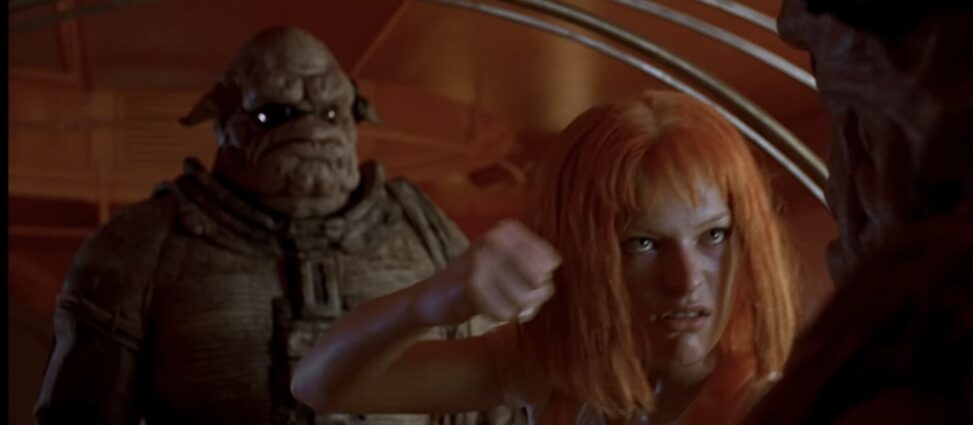The most recent action film that I have watched also happens to be my favourite movie, The Fifth Element. It is an Action-Adventure Sci-fi movie released in 1997 it was nominated for best sound editing at the 1998 academy awards. In my opinion it has great worldbuilding and a spectacular cast, accompanied by immersive set designs and costumes. The action in this movie is intense, violent, and makes the protagonist(s) believable as heroes. Budget of The Fifth Element was an estimated $75,210,000 French Franc’s. After it was all said and done the film made $263,920,180. Over 200,000,000 million dollars of that money is being made in its international audience.
There are plenty of action scenes in this movie that revolve around the two protagonists. The action scene I am going to be analyzing for this report is one involving the woman protagonist LeeLoo. LeeLoo is a genetically engineered supreme being (Fifth Element) created by the US military in the future, she could be seen as a symbol the US military’s might throughout the movie, however I do not believe that the DoD cooperated with this movie. A summary of this story would follow typical action movie stereotypes and scenarios. Heroes are trying to get four elemental stones to a pyramid and use a fifth elemental stone to stop evil incarnate from trying to destroy earth. (1) LeeLoo meets Korbin Dallas shortly after being craeted by leaping off a endlessly tall building and lading in his cab then they get shot at and evaded capture of the police, Korbin then takes her to a priest who led her on a journey to save the world and now she’s on a flying resort with Aliens trying to kill her once more.(2)
This brings me to the frame of the film I am analyzing, this moment is payback for LeeLoo. in the beginning of this movie, she was genetically engineered to be a “The Fifth Element” and stop absolute evil. The last remaining members of LeeLoo’s race were slaughtered by the warrior mercenary aliens called the Mangalores you see in the clip. The photo image I use in this clip is a favourite of mine, the Mangalores in this moment seem to think they have the upper hand, but Leeloo strikes the biggest Mangalore in the back first then the one she was lining up for a punch. Previously in this scene leading up the punch all the action has been interspliced and given a soundtrack with shots from elsewhere in the resort showing Miss Plavalaguna performing.
With the interlinking of the scenes, you are acutely aware of the edits and how fast the shots are paced, they last for a few seconds at most and are usually at consistent angles to show action beats. LeeLoo is portrayed properly for being a self-Proclaimed “Supreme Being”, she strikes fast and moves even faster. Fight choreography in this scene is phenomenal as LeeLoo effortlessly dodges and evades attacks coming for her and hits her foes back with enough force to toss them out of the room or kick a sword in half. LeeLoo strikes fear and shock in her opponents. She makes great use of her environment and the scene around her when she is fighting, she dives through railings, flips and cartwheels throughout the set. LeeLoo looks and acts like she is genetically superior in all forms of combat
I could say the strong female role in this movie could be the Directors intention to show how important and pivotal women are to life and the future of our race seeing as how LeeLoo is the titular “Fifth Element” and Miss Plavalaguna hold the four elemental stones within her body. However I believe this is a huge consequence of the film and speaks to the inequality of gender stereotypes in this movie as the actual “Fifth Element” is barley used as an action character and more of an exposition and eye candy stereotype and Korbin Dallas is the typical white male action lead that saves the day, this time saving the action of saving the day is kissing LeeLoo, (3) and that Miss Plavalguna is killed directly following her performance. It may lead to more filmmakers making more incorrect representations in film. In late 90’s action movies the male leads reflected shifting cultural norms as stated by (Briggs 2007) “In the wake of the increasing economic prosperity of the late 1990’s… ….it seemed that men were made to curb their more aggressive, more primal tendencies to better function in a more technologically based society… …were largely based on the perception that men, mostly white men, were being displaced in a new seemingly gender-neutral workforce” (4)


Provide Feedback